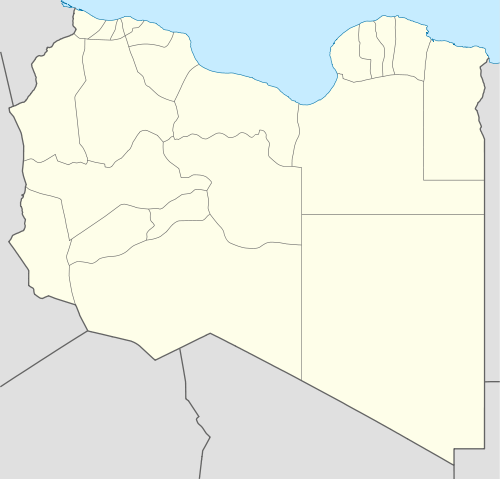Bardia
| Bardia البردية | |
|---|---|
| Town | |
|
The Port of Bardia | |
 Bardia Location in Libya | |
| Coordinates: 31°46′N 25°06′E / 31.767°N 25.100°E | |
| Country |
|
| Region | Cyrenaica |
| District | Butnan |
| Elevation[1] | 85 ft (26 m) |
| Population (2004)[1] | |
| • Total | 9,149 |
| Time zone | EET (UTC+2) |
Bardia,[2] or El Burdi (Arabic: البردية or البردي) is a Mediterranean seaport in the Butnan District of eastern Libya. It is also seldom known as Bórdi Slemán.[3]
History
In Roman times the town was known as Petras Maior.[4]
During World War I, German U-boats made several landings in the port of Bardia in support of the Senussi order during their revolt against British and Italian colonial rule.[5]
During World War II, it was the site of a major Italian fortification, invested by the XXIII Corps under the command of General Annibale Bergonzoli.[6] On 21 June 1940, the town was bombarded by the 7th Cruiser Squadron of the Mediterranean Fleet. The bombardment force consisted of the French battleship Lorraine, British cruisers HMS Orion and HMS Neptune, the Australia cruiser HMAS Sydney, and the destroyers HMS Dainty, Decoy, Hasty, and HMAS Stuart.[7] However the bombardment is reported to have only caused minimal damage. The town was taken during Operation Compass by Commonwealth forces consisting mainly of the Australian 6th Division in fighting over 3–5 January 1941.
The Axis later reoccupied the town and set up a prisoner of war camp there. On 2 January 1942, Bardia was re-taken by the South African 2nd Infantry Division, led by 1st Battalion, Royal Durban Light Infantry,[8] supported by the New Zealand Divisional Cavalry Regiment.[9] The South Africans lost approximately 160 men,[8] and the operation freed about 1,150[8] Allied prisoners of war (including 650 New Zealanders) and took some 8,500 Axis prisoners (German and Italian).[10][8]
Bardia again changed hands in June 1942, being re-occupied by Axis forces for a third time, but was abandoned without contest in November following the Allied victory at El Alamein.[9]
Bardia is the location of a unique mural created during World War II, a favorite site to visit by tourists, known as the Bardia Mural.[11]

References
- 1 2 Wolfram Alpha
- ↑ Bardīyah (Approved)) at GEOnet Names Server, United States National Geospatial-Intelligence Agency
- ↑ Bórdi Slemán (Variant) at GEOnet Names Server, United States National Geospatial-Intelligence Agency
- ↑ Stern, Robert Cecil (2007) The hunter hunted: submarine versus submarine : encounters from World War I Naval Institute Press, Annapolis, Maryland, note 15 of Chapter 13, page 205, from page 94, ISBN 978-1-59114-379-6
- ↑ Hans Werner Neulen: Feldgrau in Jerusalem. 2. Aufl., Universitas, München 2002, S. 100 ff., ISBN 3-8004-1437-6.
- ↑ Collier, Richard (1977) The War in the Desert Time-Life Books, Alexandria, Virginia, p. 29, ISBN 0-7835-5721-3 and Time-Life Books (1990) Afrikakorps Time-Life Books, Alexandria, Virginia, p. 15, ISBN 0-8094-6983-9
- ↑ http://www.sydneymemorial.com/history.htm, and Jürgen Rohwer (2005). Chronology of the War at Sea, 1939–1945: The Naval History of World War Two. Annapolis, MD: Naval Institute Press. ISBN 978-1-59114-119-8, p.29
- 1 2 3 4 U.S. War Department, WWII (25 July 1942). "The British Capture of Bardia (December 1941 – January 1942): A Successful Infantry-Tank Attack". Lone Sentry. Washington, DC: Military Intelligence Service, Information Bulletin No. 21. p. MID 461. Retrieved 27 December 2014.
- 1 2 "Battle of Bardia". Australian Military Units. Australian War Memorial. Retrieved 28 December 2014.
- ↑ Loughman, R. J. M. (1963) "Chapter 9: The Capture of Bardia" Divisional Cavalry War History Branch, New Zealand Department of Internal Affairs, Wellington, New Zealand, pp. 149–168
- ↑ Simmonds, Donald "Bardiyah (Bardia) Masterpiece"
Further reading
- Stevens, William George (1962) Bardia to Enfidaville War History Branch, New Zealand Department of Internal Affairs, Wellington, New Zealand, OCLC 4377202; history of New Zealand troops in North Africa in World War II
- Agar-Hamilton, J. A. I. and L. C. F. Turner. The Sidi Rezegh Battles, 1941. Cape Town: Oxford University Press, 1957.
| Wikimedia Commons has media related to Bardia. |
Coordinates: 31°46′N 25°06′E / 31.767°N 25.100°E
